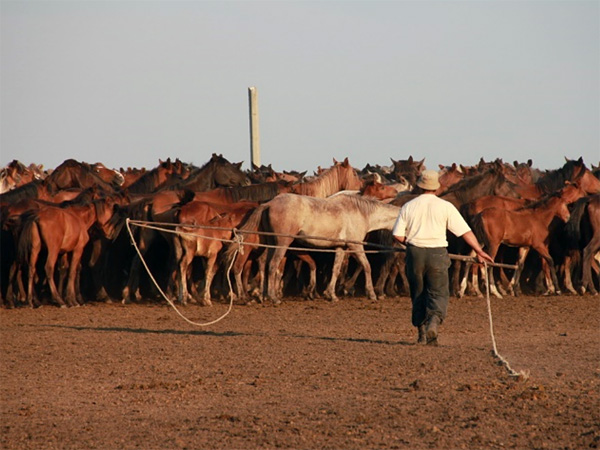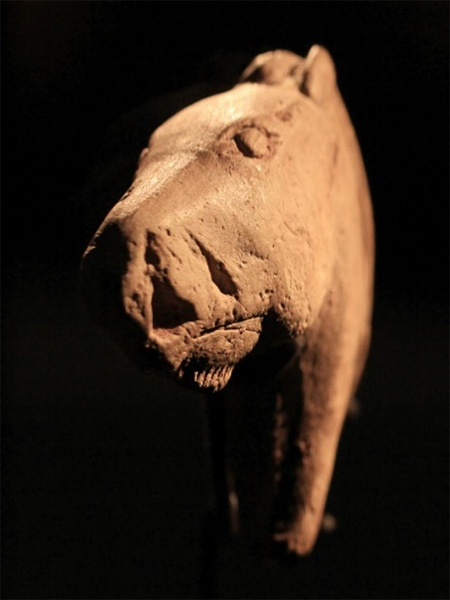The mystery of the origin of the domesticated horses is solved! – new publication in Nature
Where and when were horses first domesticated? The latest research published in Nature shows that it took place in the Pontic-Caspian steppes, in the northern Caucasus, around 2200 BC. Hence, in the centuries that followed, domesticated horses spread throughout Asia and Europe, giving rise to modern horse breeds.
The discovery was made by an international team of 162 scientists, specializing in archaeology, palaeogenetics and linguistics, led by Prof. Ludovic Orlando, paleogenetics from the Centre for Anthropobiology and Genomics of Toulouse (CNRS/Université Toulouse III – Paul Sabatier). The research team included scientists from the W. Szafer Institute of Botany PAS: Dr. Tomasz Suchan, who was a Marie Skłodowska-Curie postdoctoral fellow at Prof. Orlando's laboratory, and Dr. Magdalena Moskal-del Hoyo.
Scientists sequenced 273 genomes of ancient horses scattered across Eurasia and compared them with data from today's populations. In this way, they confirmed that Eurasia was once inhabited by genetically distinct populations of wild horses. Between 2200 and 2000 BC, a dramatic change took place: a single genetic profile, previously confined to the North Caucasus steppes, began to spread beyond its native range, replacing all wild populations from the Atlantic to Mongolia within a few centuries. The genetic data point to the explosive demography of this species at the time, with no equivalent in the last 100,000 years. The scientists also found two striking differences between this horse's genome and those of the replaced populations: one is linked to a more docile behaviour and the second indicates a stronger backbone. These traits made the animals successful at a time when horse travel was becoming "global".
The results of the research lead to the conclusion that the migrations of Indo-Europeans from the steppes to Europe in the third millennium BC, related to the Yamnaya culture, could not be based on the horse because its domestication and diffusion occurred later, i.e. at the same time as the spoke-wheeled chariots, associated with the Sintaszta-Pietrovka culture, and the Indo-Iranian languages. These new discoveries demonstrate how important it is to integrate animal history into studies of human migrations and intercultural relationships.
Original article:
Librado P., Khan N., Fages A., Kusliy M.A., Suchan T., Tonasso-Calvière L., Schiavinato S., Alioglu D., Fromentier A., Perdereau A., Aury J.-M., Gaunitz C., Chauvey L., Seguin-Orlando A., Der Sarkissian C., Southon J., Shapiro B., Tishkin A.A., Kovalev A.A., Alquraishi S., Alfarhan A.H., Al-Rasheid K.A.S., Seregély T., Klassen L., Iversen R., Bignon-Lau O., Bodu P., Olive M., Castel J.-C., Boudadi-Maligne M., Alvarez N., Germonpré M., Moskal-del Hoyo M., Wilczyński J., Pospuła S., Lasota-Kuś A., Tunia K., Nowak M., Rannamäe E., Saarma U., Boeskorov G., Lōugas L., Kyselý R., Peške L., Bălășescu A., Dumitrașcu V., Dobrescu R., Gerber D., Kiss V., Szécsényi-Nagy A., Mende B.G., Gallina Z., Somogyi K., Kulcsár G., Gál E., Bendrey R., Allentoft M.E., Sirbu G., Dergachev V., Shephard H., Tomadini N., Grouard S., Kasparov A., Basilyan A.E., Anisimov M.A., Nikolskiy P.A., Pavlova E.Y., Pitulko V., Brem G., Wallner B., Schwall C., Keller M., Kitagawa K., Bessudnov A.N., Bessudnov A., Taylor W., Magail J., Gantulga J.-O., Bayarsaikhan J., Erdenebaatar D., Tabaldiev K., Mijiddorj E., Boldgiv B., Tsagaan T., Pruvost M., Olsen S., Makarewicz C.A., Valenzuela Lamas S., Albizuri Canadell S., Nieto Espinet A., Iborra M.P., Lira Garrido J., Rodríguez González E., Celestino S., Olària C., Arsuaga J.L., Kotova N., Pryor A., Crabtree P., Zhumatayev R., Toleubaev A., Morgunova N.L., Kuznetsova T., Lordkipanize D., Marzullo M., Prato O., Bagnasco Gianni G., Tecchiati U., Clavel B., Lepetz S., Davoudi H., Mashkour M., Berezina N.Ya., Stockhammer P.W., Krause J., Haak W., Morales-Muñiz A., Benecke N., Hofreiter M., Ludwig A., Graphodatsky A.S., Peters J., Kiryushin K.Yu., Iderkhangai T.-O., Bokovenko N.A., Vasiliev S.K., Seregin N.N., Chugunov K.V., Plasteeva N.A., Baryshnikov G.F., Petrova E., Sablin M., Ananyevskaya E., Logvin A., Shevnina I., Logvin V., Kalieva S., Loman V., Kukushkin I., Merz I., Merz V., Sakenov S., Varfolomeyev V., Usmanova E., Zaibert V., Arbuckle B., Belinskiy A.B., Kalmykov A., Reinhold S., Hansen S., Yudin A.I., Vybornov A.A., Epimakhov A., Berezina N.S., Roslyakova N., Kosintsev P.A., Kuznetsov P.F., Anthony D., Kroonen G.J., Kristiansen K., Wincker P., Outram A., Orlando L. 2021. The origins and spread of domestic horses from the Western Eurasian steppes. Nature 598: 634–640. DOI
See also the project website.

Kazakh farmer catching horses in north-central Kazakhstan.
Photo: Courtesy of Ludovic Orlando / CAGT / CNRS Photothèque.

Magdalenian horse figurine from Duruthy, France. Abbaye d'Arthous. Collections of the Landes Department.
Photo: Ludovic Orlando.





